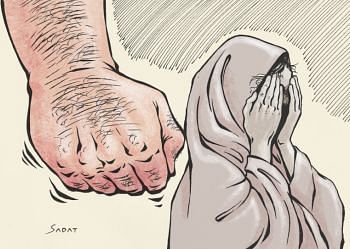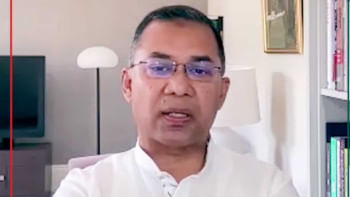Gender Based Violence: Impediment to women empowerment

“In October 2000, after a severe beating from my husband, I took my six-month-old daughter to my father's house. The next morning, my father sent me back home after giving me some rice and fifty taka. But my husband, upon seeing me, started beating me again. He pushed me out of the house and told me to go back to my father's house. He forcibly kept our young daughter with him. I had no choice but to return to my father's house. The next day, my husband's younger brother came to me bearing the news that my daughter had died. Fearing that I may be harmed, the head of the village and local elders restrained me from seeing my daughter. My sister's husband went instead and found that the child had been buried.
Within the same month, my father filed a case against my husband. Immediately on hearing the news, my husband with the politically influential Chairperson (elected sub-district Representative), along with the same village head who prevented me from seeing my child, began to pressure my family to retract the case. A shalish was arranged and my husband was made to give me one thousand four hundred taka as compensation and my family was told to withdraw the case.”
The above case study was documented in 2000 by Odhikar, a human rights organization.
The lady told Odhikar investigators that her family lacked the economic support to carry on a case and thus decided to withdraw the case filed nor does she want to return to her husband's home. She is afraid that she will meet the same fate as her six-month-old daughter, who is believed to have been murdered.
This is a typical story of abuse in our country where the husband abuses and finally abandons his wife and drifts away. He will possibly marry again somewhere and bear more children. There is no mechanism in place to track down such fiends and make them pay for causing so much physical, psychological and economic damage to young girls in society.
Dr. Ruchira Naved a senior scientist with ICDDR, B's Centre for Equity and Health Systems carried out the first multi-country study of gender-related attitudes and practices that reported on men focusing on masculinities in 2013 named “Role of masculinity, men's attitudes and childhood experiences in intimate partner violence,” as the principal investigator for the Bangladesh part of the survey she concluded that in Bangladesh 62% of rural men believed that there are times when a woman deserves to be beaten. Up to 45% of men admitted perpetrating violence towards an intimate partner. The survey reported that almost all violence occurs within marriage.
WHO's multi-country study (10 countries including Bangladesh) demonstrates that most of the women in the educational institution sector experience physical and sexual spousal violence in their lifetime, ranged from 15% to 71% (WHO Study: “Violence against women by male intimate partners.”). Worldwide, 600 million women are living in countries where domestic violence is still not against the law (UN source). One in every three women has been beaten, coerced into sex or abused in some other way – most often by someone she knows. (Moradian, 1998. "Violence against women in Iranian society").
In Bangladesh, VAW is a very common practice which denies women's equal opportunity, security, self-esteem, and dignity in the family and in the society as a whole and encompasses many forms of violence, such as sexual assault, domestic violence, socioeconomical violence, child marriage, dowry killings. Bangladesh has the highest prevalence of physical violence against an intimate partner out of six in Asia-Pacific countries. Recent surveys done by Bangladesh Demographic and Health Services (BDHS) showed that 87% of married women experience violence by their current spouse (Violence Against Women Survey, BBS 2011).
Orientation of a culture or the shared beliefs within a sub culture defines, what is considered to be tolerable behavior. Some societies value violence and attach prestige to it; others term it as legitimate or normal conduct. In some cultures rape, domestic and sexual assault can all be termed as cultural norms, but are truly just violent expressions of gender inequality. (Source: Chapell D. and Di Martino V., 1998. Violence at Work, Geneva, ILO.).
Economic costs of violence against women include direct costs such as services and bringing perpetrators to justice, as well as indirect costs such as lost earnings for women, lost employment for businesses, customary requirements such as dowry and bride prices. Besides obvious physical trauma, there is an intangible psychological trauma and fear experienced by the victim that can affect her for prolonged periods. Once the physical injuries heal, the victim suffers from memories of the incident of violence as well as the new label of shame and disgust subjugated on her by society. This highlights the incessant need for a compassionate and methodical support system. (Source: Chapell D. and Di Martino V., 1998. Violence at Work, Geneva, ILO.).
While women are usually the immediate victims of gender violence, the consequences of gender violence extends beyond the victim to the society as a whole. Gender violence threatens family structures; children suffer emotional damage when they watch their mothers and sisters being battered. Psychological scars often impede the establishment of healthy and rewarding relationships in the future. Victims of gender violence may vent their frustrations on their children and others, thereby transmitting and intensifying the negative experiences of those around them. Children, on the contrary, may come to accept violence as an alternative means of conflict resolution and communication.
UNFPA intiaties to protect the health and rights of adolescent girls through comprehensive sexuality education; through sexual and reproductive health counselling, information and services; and through youth participation, UNFPA works to protect human rights of adolescent girls. They also work with boys so they will become the first male generation to neither perpetrate nor tolerate violence against women and girls. Bangladesh has the highest percentage of Child Marriage at 64% according to a recent survey done by Plan Bangladesh. UNFPA-UNICEF has developed Theory of Change (TOC) to eliminate Child marriage. Based on the TOC, a National Programme on Child Marriage is currently under development.
Further actions of documentation and publications of violations against human rights defenders, journalists, indigenous and marginalized groups can be done. It is crucial that community members and policy makers at local, national, international and other influential levels co-operate to eradicate gender-based violence as a priority. Work done by the Women Human Rights Defenders must be given more importance and supported. State and non-State perpetrators of violence must be held accountable through national, regional and international mechanisms.
Proper utilization of the mass media can also lead to a higher reception from the public. It is important for the media to stop promoting women as weak, fragile and at times objects of just mere superficial aesthetical value. Instead they need to support as well as broadcast the message of equity among genders and women empowerment.

 For all latest news, follow The Daily Star's Google News channel.
For all latest news, follow The Daily Star's Google News channel. 



Comments